Models
The aim of Biowise Farm is to demonstrate an integrated facility that utilizes and treats City’s Biodegradable waste to create a closed loop system of solid waste management. It does not end there; it takes the next logical step, to utilize treated resources in the waste to rejuvenate the soil and using natural nutrients and bio control methods to produce safe farm food for consumption. We have named this process as regenerative farming.
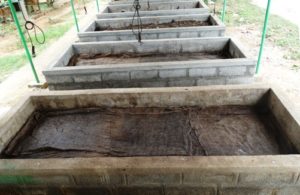 Composting is a simple way to add nutrient-rich humus which fuels plant growth and restores vitality to depleted soil. It’s also free, easy to make, and good for the environment. Compost is made up of organic materials that break down in the soil, enriching its structure and adding essential nutrients. To understand the composting process, it helps to look at the natural decomposition process found in nature. For instance, wooded areas are filled with organic materials—trees, leaves, etc. Over time these materials slowly decompose, or break down, with the help of micro-organisms and earthworms. Once the materials have decomposed, it turns into humus, an essential element in the production of rich, fertile soil and is also responsible for producing healthy plants. Numerous benefits are associated with the use of compost.
Composting is a simple way to add nutrient-rich humus which fuels plant growth and restores vitality to depleted soil. It’s also free, easy to make, and good for the environment. Compost is made up of organic materials that break down in the soil, enriching its structure and adding essential nutrients. To understand the composting process, it helps to look at the natural decomposition process found in nature. For instance, wooded areas are filled with organic materials—trees, leaves, etc. Over time these materials slowly decompose, or break down, with the help of micro-organisms and earthworms. Once the materials have decomposed, it turns into humus, an essential element in the production of rich, fertile soil and is also responsible for producing healthy plants. Numerous benefits are associated with the use of compost.
- It can enhance the soil, building up the structure and texture.
- It increases airflow and water retention.
- Compost also stabilizes pH level and supports essential microorganisms that thrive on it.
- Compost allows plants to effectively use nutrients for obtaining healthier growth as well.
- The organic matter found in compost encourages a variety of living organisms which helps in aerating the soil. Other benefits include erosion control and the reduction of soil-borne diseases
Biowise farm largely depends upon organic waste management by converting it into compost. We practice a variety of composting methods like stack method, usage of microbial culture, forced aeration method, vermin composting, and windrow composting. A Visitor to the farm will be able to get much of the details of these forms of composting.
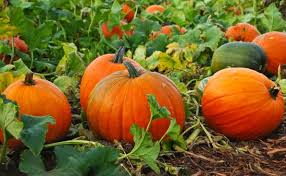 Our business model is based on products and services offered by our Company through the micro farm. We supply farm fresh vegetables, fruits, micro greens, herbs and animal products that are free from toxic elements to niche markets of Bangalore. We offer to the urban consumers toxic free horticultural products in the form of ” Weekly Family Basket” of condiments including fresh water fish, milk and eggs. Value added compost production is the biggest revenue generator with scope for production of soil mix, seed starter, pot mix, garden soil and plant/ lawn growth boosters. We offer urban consumers training in the form of gardening in small urban spaces like balconies, terraces, windowsills and home garden spaces charging a nominal fee for participation. Our plant nursery consists of saplings of ornamental flowers, vegetable, medicinal & edible herbs and garden inputs for sale. These are exhibited to urban consumers during our training programs, weekly sales and special training cum sales events. Governmental funds are sourced to train farmers and for their exposure visits. We have plans to enable small and marginal farmers as our franchisees that consume farm inputs from us and at the same time enabling them as suppliers of clean horticultural produce. Over the years we have reduced farm consumables drastically in purchase of soil inputs, bio control products, cattle/poultry feed and thru usage of simple farm machinery. Our key costs remain as labour costs in production.
Our business model is based on products and services offered by our Company through the micro farm. We supply farm fresh vegetables, fruits, micro greens, herbs and animal products that are free from toxic elements to niche markets of Bangalore. We offer to the urban consumers toxic free horticultural products in the form of ” Weekly Family Basket” of condiments including fresh water fish, milk and eggs. Value added compost production is the biggest revenue generator with scope for production of soil mix, seed starter, pot mix, garden soil and plant/ lawn growth boosters. We offer urban consumers training in the form of gardening in small urban spaces like balconies, terraces, windowsills and home garden spaces charging a nominal fee for participation. Our plant nursery consists of saplings of ornamental flowers, vegetable, medicinal & edible herbs and garden inputs for sale. These are exhibited to urban consumers during our training programs, weekly sales and special training cum sales events. Governmental funds are sourced to train farmers and for their exposure visits. We have plans to enable small and marginal farmers as our franchisees that consume farm inputs from us and at the same time enabling them as suppliers of clean horticultural produce. Over the years we have reduced farm consumables drastically in purchase of soil inputs, bio control products, cattle/poultry feed and thru usage of simple farm machinery. Our key costs remain as labour costs in production.
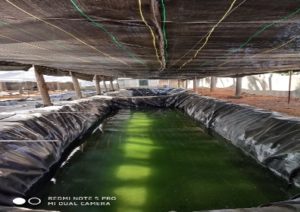 Aquaponics is a form of agriculture that combines raising fish in tanks or ponds (recirculating aquaculture) with soilless plant culture (hydroponics). In aquaponics, the nutrient-rich water from raising fish provides a natural fertilizer for the plants and the plants help to purify the water for the fish. Combination Fish culture and Hydroponics viz called aquaponics is not something most farmers would indulge in for lack of expertise, non-existing models to learn from, and for fear of losing money in experimentation. At Biowise farm, we have attempted in creating an aquaponics farming system to enable smallholding farmers to earn additional income in the usage of the land. In many ways, the project is unique to suburban farmers even though fish culture and income from sale freshwater fish are sparsely prevalent in the area.
Aquaponics is a form of agriculture that combines raising fish in tanks or ponds (recirculating aquaculture) with soilless plant culture (hydroponics). In aquaponics, the nutrient-rich water from raising fish provides a natural fertilizer for the plants and the plants help to purify the water for the fish. Combination Fish culture and Hydroponics viz called aquaponics is not something most farmers would indulge in for lack of expertise, non-existing models to learn from, and for fear of losing money in experimentation. At Biowise farm, we have attempted in creating an aquaponics farming system to enable smallholding farmers to earn additional income in the usage of the land. In many ways, the project is unique to suburban farmers even though fish culture and income from sale freshwater fish are sparsely prevalent in the area.
Currently, we have dug up two ponds measuring 50 feet length, 14 feet wide, and 6 feet deep. The ponds are covered with 500 microns plastic sheet and store water to a depth four and a half feet. The top of the pond is covered with black shade net prevent leaf litter and birds. Adjacent to the pond eight grow bed of 12 feet length, 4 feet width and one and a half feet depth is covered 250-micron plastic sheet. To facilitate sunlight for the grow beds, the top is covered by a white shade net of 50% transparency. Eight of the grow beds has one feet deep gravel and two grow beds will floating raft. The system has two one hp pumps to draw water from the pond to the grow bed and one compressor to blow air and to oxygenate the water. 1000 Fish seedlings of Grass Carp variety fishes are introduced in the ponds as first crop. Currently, the sale of this variety is underway.
The primary benefits of Aquaponics Farming are:
- Environmentally responsible for low water usage and low power usage.
- The primary inputs to the system are Fish food and water.
- Little to no Chemical usage. …
- Many of the plants that thrive in Aquaponic growing are very easy to grow.
- Low susceptibility to pests and diseases
Aquaponics Farming makes it possible to grow your own fresh vegetables and fish. The combination of fish and plants creates a smart, sustainable cycle. The plants are fed by the poop of the fish while the plants purify the water for the fish.
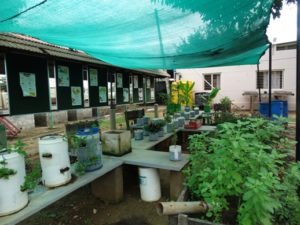 Balcony Garden:
Balcony Garden:
Balcony garden is a demonstration of using small urban spaces like balconies, shelves, windowsills, terrace and kitchen garden areas to grow critical food nutrients like salad crops, leafy vegetables, greens, tomato, okra, beans etc. Yes, you can grow your own pesticide free nutrients at your home. Create three green dots in your home. One for composting leftover food materials, second for growing your own vegetables in small urban spaces and the third one is to use what you have grown on your dining table. (Credit Concept: Three Green Dots Campaign, SWMRT, Bengaluru)
Waste Garden:
As the name suggests, waste garden structures demonstrate the use of waste materials. Sustainability in waste management involves 6 R’s viz Rethink, Research, Reduce, Recycle, Reuse, Refuse and plus, raising community awareness regularly. Waste is a resource, making use of it WISELY, is the need of the hour.
Raised Bed gardening:
Raised beds offer a simple and effective way to create a healthy and productive garden by creating an environment for plant to grow. And the best part is, no matter how bad the ground you’re starting with, ideal planting conditions can be created for soil structure and drainage that is key to success. Raised garden beds are great for growing small plots of veggies and flowers. They help in removal of weeds, prevent soil compaction and serve as a barrier to pests
Vegetable and Herbal Garden:
India is a tropical country with abundance of growth of vegetables, fruits, greens and edible herbs. Our ancestors have ensured in the Indian Cuisine, variety of spices and its combinations to be used as food materials to nourish our body and mind. It is incredible that we possess such a variety of foods and habits as a part of daily living and yet not aware of it. Ayur (Life) Veda (Knowledge – Science) is an ancient, natural, holistic Indian system is roots in “Living tune with Nature” and nature has bountiful in its produce for living creatures.
Medicinal Herbs and Plants
Medicinal plants have been identified and used throughout human history. Plants make many chemical compounds that are for biological functions relieving common ailments like indigestion, stress, anxiety, sunburn, headaches, coughs, colds, and more. Herbs have a variety of uses including culinary, medicinal, and in some cases spiritual usage.
Green House Cultivation
Any gardener or farmer knows planting crops outside depends wholly on weather patterns and conditions that must be suitable for seeds to take root and thrive. A greenhouse is a structure with a covering (either glass or plastic cover) which is used to control temperature and humidity in the cultivation and protection of plants. When you have a greenhouse, you effectively have your own little micro-environment that you can control. Green house helps growing carefully chosen vegetables, herbs and flowers throughout the year by controlling the weather inside the green house. The fact of growing in a favorable closed condition also prevents attack of pests and disease and protects the plants inside.
Mini biogas plant:
Decomposable organic material from kitchen in the form of vegetable and fruit peels, leftover food, and wastewater (after cleaning vegetables/plates/vessels) can be converted into Bio Gas as alternative fuel. In this way, biodegradable, wet organic materials originating from your home can be disposed of efficiently. The major components of biogas plant are inlet for feeding kitchen waste, digester tank, gas holding tank, gas delivery system for taking out and utilizing the produced gas and an outlet for digested slurry. The digested slurry from biogas unit can be used as compost in your garden.
Eco San Toilet – is alternative to conventional toilet
Ecosan toilet is also called dry toilet is based on principle of recovery and recycling of nutrients from excreta, urine and wash water. In an Ecosan toilet excreta, urine and wash water are not mixed. Each has separate channel for collection and utilization. Urine and wash water find immediate use in agriculture. Urine has valuable nutrients for plant growth. Urine is diluted with water and when applied, it is absorbed by plant straight away. Ecosan toilet has two chambers built above the ground for collection of excreta. On daily usage, when the first chamber is filled with excreta, it is closed and sealed. A user uses the second chamber for daily chores. After about six months, the feces within the first chamber is completely dried/composted, all pathogens are destroyed and can be applied as manure for plants. Use of water in eco san toilet is limited and it is an alternative to places where water is scarce, or water table is high. A farmer gets his quota of fertilizer from day one for agriculture purposes.
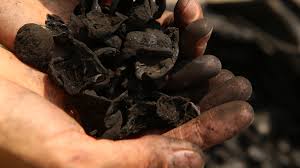 Biochar is a type of fine-grained charcoal created by burning wood and agricultural byproducts slowly, at low temperatures, with a reduced oxygen supply. Although biochar is a new term, use of the substance in gardens is not a new concept. In fact, researchers believe that early residents of the Amazon rainforest enhanced soil productivity by using biochar, which they produced by burning agricultural waste slowly in trenches or pits.
Biochar is a type of fine-grained charcoal created by burning wood and agricultural byproducts slowly, at low temperatures, with a reduced oxygen supply. Although biochar is a new term, use of the substance in gardens is not a new concept. In fact, researchers believe that early residents of the Amazon rainforest enhanced soil productivity by using biochar, which they produced by burning agricultural waste slowly in trenches or pits.
We produce Biochar at the farm by burning used and dried coconut shells, branches, left over wooden pieces, farming waste materials through an equipment called rocket stove where biomass is burned in the absence of oxygen through a slow burning process. Bio Char is then powered and added to compost stack to enrich the compost. Biochar has several potential agricultural benefits which include an increase in crop yield, mitigating nutrient loss, reduce fertilizer’s runoff, improve soil structure, and improving the water-holding capacity of soils.
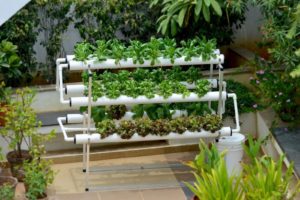
Hydroponics is a subset of hydroculture, which is a method of growing plants without soil. Hydroponics, by definition, is a method of growing plants in a water-based, nutrient-rich solution. Hydroponics does not use soil, instead, the root system is supported using an inert medium such as perlite, rockwool, clay pellets, peat moss, or vermiculite..At the farm, we grow leafy vegetables like spinach, lettuce and microgreens using Hydroponics systems.

Azola is a free-floating water fern consisting of a short, branched, floating stem, bearing roots that hang down in the water. It’s a kind of green fodder grown on the water surface. It can fix atmospheric nitrogen, carry out photosynthesis, and uptake nutrients from its surrounding environment through its root system. It has a wide range of use including fodder for dairy cattle, pigs, chicken, ducks, and fish. Azolla can be used for all type of vegetables and plantation crops
As green manure, Azolla has grown alone for two to three weeks. A handful of fresh Azolla is applied in standing water and could be harvested within two weeks. Dry Azolla flakes can be used as poultry feed and green Azolla is also a good feed for fish. It can be used as a bio-fertilizer, a mosquito repellent, in the preparation of salads and above all as a bio-scavenger as it takes away all heavy metals.
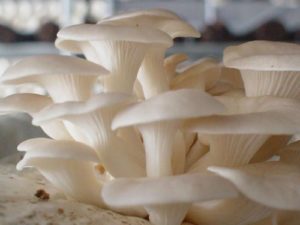 Oyster mushrooms are a type of edible fungi. They are one of the most widely consumed mushrooms in the world. They get their name from their oyster-shaped cap and very short (or completely absent) stem. They’re also like the color of raw oysters. The growing technology is simple and widely spread across rural India. We do produce Oyster mushroom as an Integrated approach to farming.
Oyster mushrooms are a type of edible fungi. They are one of the most widely consumed mushrooms in the world. They get their name from their oyster-shaped cap and very short (or completely absent) stem. They’re also like the color of raw oysters. The growing technology is simple and widely spread across rural India. We do produce Oyster mushroom as an Integrated approach to farming.